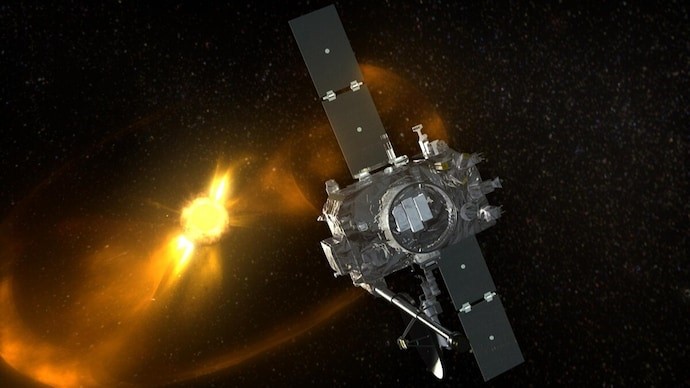Description

Disclaimer: Copyright infringement not intended.
Context
- In a significant development, NASA's Solar Terrestrial Relations Observatory (STEREO-A) spacecraft underwent its first Earth flyby, nearly 17 years after its initial launch.
- This event presents a unique opportunity for collaboration with other missions in Earth's vicinity, promising fresh insights into the behavior of our Sun.
Details
Mission Background
- Launched from Cape Canaveral on October 25, 2006, the STEREO mission consists of twin spacecraft: STEREO-A and STEREO-B.
- The primary objective of the mission was to provide a stereoscopic view of the Sun, enabling a multi-perspective understanding of solar phenomena.
Milestone Achieved
- On February 6, 2011, a significant milestone was accomplished as the two spacecraft achieved a 180-degree separation in their orbits.
- This configuration allowed humanity to witness the Sun as a complete sphere for the first time.
Stereoscopic Vision and Earth Flyby
- The upcoming Earth flyby will enable STEREO-A to once again employ stereoscopic vision, a technique that extracts 3D information from two-dimensional images. This approach mimics the human depth perception created by our two eyes.
- STEREO-A will combine its views with data from other missions, including NASA's Solar and Heliospheric Observatory (SOHO) and Solar Dynamics Observatory (SDO), operated by both NASA and the European Space Agency (ESA).
- As STEREO-A's distance from Earth changes during the flyby, it will adjust its stereo vision to observe solar features of varying sizes, akin to focusing a vast telescope spanning millions of miles.
- This optimized perspective will enable scientists to study active regions beneath sunspots and uncover 3D structural information. Additionally, a new theory suggesting that coronal loops might be optical illusions will be tested.
.jpg)
Understanding Coronal Mass Ejections (CMEs)
- One of the key objectives of the flyby is to study the evolution of the magnetic field within coronal mass ejections (CMEs) as they journey towards Earth.
- CMEs, which are plumes of solar material, can disrupt satellite communications, radio signals, and power grids. By obtaining multipoint measurements from within a CME, scientists aim to enhance their computational models of these solar eruptions.
Changing Solar Activity
- The timing of this Earth flyby marks a notable contrast to STEREO-A's early days in 2006 when the Sun was relatively tranquil due to the solar minimum. Presently, as the Sun approaches the solar maximum predicted for 2025, it exhibits heightened activity.
- This shift in solar behavior offers STEREO-A a fresh perspective, granting researchers access to a range of solar phenomena that were less prevalent during its earlier observations.
Mission Objectives
- Observing Solar Phenomena: STEREO aims to provide 3D images of the Sun, allowing scientists to observe and understand solar phenomena such as coronal mass ejections (CMEs), solar flares, and other dynamic processes.
- Space Weather Prediction: By tracking solar activities, STEREO helps in improving space weather predictions, which are crucial for protecting satellites, astronauts, and technological infrastructure from the harmful effects of solar radiation and energetic particles.
- Studying Solar Wind: The mission aims to study the solar wind's behavior as it travels through space, interacting with Earth's magnetosphere and shaping the space environment around our planet.
Spacecraft Design
- Twin Spacecraft: STEREO consists of two nearly identical spacecraft: STEREO-A (Ahead) and STEREO-B (Behind). They were launched together and followed separate trajectories to achieve their respective positions around the Sun.
- Orbit: STEREO-A moves ahead of Earth, gradually moving ahead of our planet's orbit, while STEREO-B trails behind, gradually falling behind Earth's orbit. This positioning enables the stereoscopic observation of solar events.
- Instruments: Each spacecraft is equipped with instruments such as the In-situ Measurements of Particles and CME Transients (IMPACT) suite, which includes various sensors to measure solar wind characteristics, magnetic fields, and particle energies.
Scientific Discoveries
- CME Evolution: STEREO data revealed the evolution of CMEs as they travel through space, helping scientists model their trajectories and potential impacts on Earth.
- Solar Wind Properties: The mission's measurements of solar wind properties, including speed, density, and magnetic field strength, have deepened our knowledge of the solar wind's behavior.
- Solar Flare Insights: STEREO has provided insights into the development of solar flares and their association with magnetic activity on the Sun's surface.
Legacy and Impact
- Space Weather Research: STEREO's data continues to be valuable for space weather researchers, aiding in the development of predictive models and strategies to mitigate the impacts of space weather on technology and infrastructure.
- Solar Physics Advancements: The mission's observations have led to advancements in our understanding of solar physics, contributing to broader knowledge about the Sun's behavior and its effects on the solar system.
- Technological Innovation: STEREO's success in using twin spacecraft for stereoscopic imaging has influenced the design of future space missions that require multiple viewpoints for enhanced observations.
Conclusion
The STEREO spacecraft mission has significantly contributed to our understanding of the Sun's dynamics and its impact on space weather. Through its innovative twin spacecraft design and advanced instruments, STEREO has provided groundbreaking insights into solar phenomena, improving our ability to predict and manage space weather events for the benefit of Earth and its technological infrastructure.
|
PRACTICE QUESTION
Q. Discuss the significance of the STEREO spacecraft mission in advancing our understanding of the Sun and its impact on space weather. Highlight its technological innovations, key discoveries, and contributions to space weather prediction and research. (150 Words)
|

https://www.indiatoday.in/science/story/nasa-spacecraft-prepares-for-rare-earth-flyby-17-years-after-it-left-planet-2419664-2023-08-11











